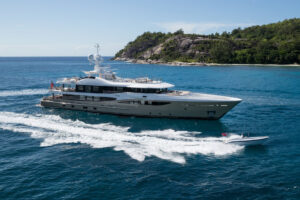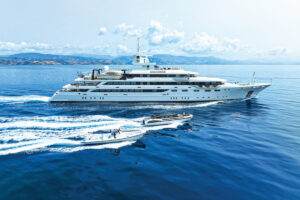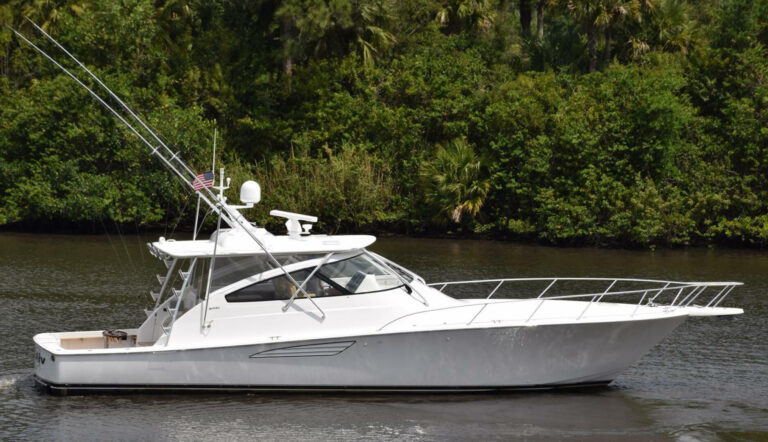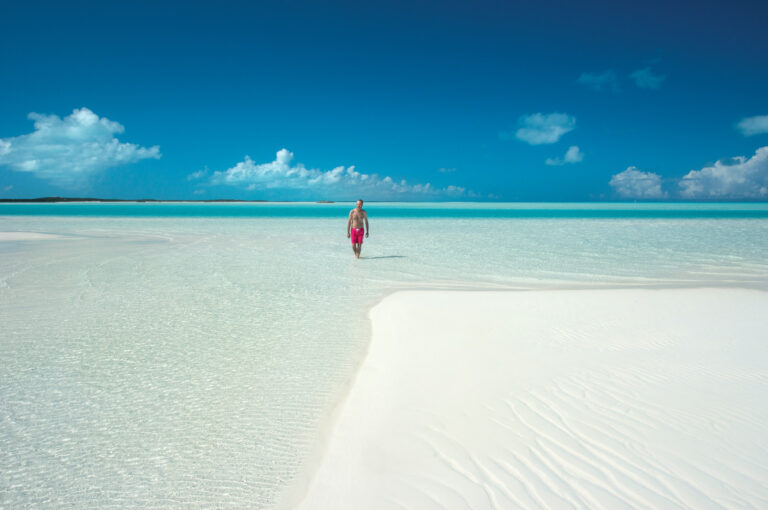One of the many challenges we faced when we decided to motor our 86-foot power cat Pacific Harmony from New Zealand to Florida was how it would work with our children-Jonathan age 5 and Marcus age 1. Chartering in Auckland during the 2003 America’s Cup was straightforward for the family. Being an owner/operator/developer of a luxury charter yacht, I came home each night after VIP guests enjoyed the races. The cup had gone to Europe and the glut of charter boats meant it was time to sell. The place to do so was Florida, and we had only two alternative methods of getting her there-on her own bottom or aboard a freighter.
We decided to motor ourselves, which seemed much less expensive than shipping. Pacific Harmony sips fuel, so she has a range of more than 3,000 miles on only 3,500 gallons of fuel. She could travel a distance of around 1,000 miles at 20 knots, which is not bad for an 86-footer with the interior volume of a 100-foot monohull.
We also wanted to affirm the claim that fuel-efficient cats such as these make good global explorers. We are really a trawler in a slick Italian suit, and to prove the quality of the boat, we had to go offshore. Our future charter boats would benefit from this R&D. Without it, constant improvements couldn’t take place.
To reinforce our decision to motor instead of ship Pacific Harmony, we drew on our prior experience. We had explored the Pacific for 11 months aboard our 42-foot sailing cat in 2000, so we were no strangers to the ocean. Jonathan was 2 then, and we knew kids and boats can be compatible, having seen many examples. Every tenth boat we met was a “kid boat on the cruising trail.
It’s not always an easy life coping with boats on a 9,000 mile voyage, (a.k.a. Broken Or About To, so Break Out Another Thousand), and kids make life afloat a little harder than they do ashore. Parents always face lack of sleep from kids’ waking. At sea, add long watches, windy rolly anchorages, dragging anchors, broken gear or the kids’ chewing on essential equipment, such as a VHF microphone, fiddling with the chart plotter that has no games in it, and so on. You wonder why people go to sea at all with children. Yet the family time together, seeing the remote and stunning places on the way from New Zealand to Florida was going to be the reward. Flared tempers would cool in the ambiance of beautiful tropical lagoons at sunset. Our young charter business seemed a far better way to earn a living than any office job. Instead of depressed co-workers interrupting you with mindless questions, it was wide-eyed kids interrupting you with memorable learning opportunities. So why ship an ocean-going boat when you can see it all and stop for photos?
The following story is a glimpse of life along the way with young children in French Polynesia.
Preparations for a voyage of this magnitude are not to be taken lightly. Working full time on designing, supervising construction, running charters and commissioning this boat had given me the opportunity to know how capable the boat was and to include factors that would enable round-the-world voyages such as this to take place with our precious young family aboard. Lists of spares, charts, extra safety equipment, such as a Parachute sea anchor, had to be organized, weather routing sources arranged, along with satellite communications, SSB radio operators to check in with and, of course, food. Tahiti was reputed to be obscenely expensive to our weak Pacific peso (NZ dollar). My wife shopped for weeks, buying thousands of dollars worth of fresh New Zealand meat to get us all the way to Florida. We still had our orders to catch fish though-nothing like fresh tuna in the middle of the ocean.
Our fuel range meant the tanks would get us to French Polynesia with plenty to spare. The long stretch from there to Galapagos was 3,000 miles without stops, primarily into head winds of 15 to 20 knots and 2 knots of current. That would require extra delivery tankage to increase our range by 25 percent to 4,000 miles for safety, so we had to arrange for these to be picked up in Tahiti.
Early on we had the foresight to get an au pair from Sweden to help with childcare routines. Petra came from Gothenburg, the city where my wife, Anna, spent her university years and still had family and friends to help us find the right person for such a trip. To keep the children bilingual, we needed a bilingual au pair.
Looking after two children now instead of one presented a new challenge, compared with our previous voyage on the smaller sailing cat. Would the au pair be a help or handicap at sea? Kids don’t sit still for one minute, so chasing them around a moving boat when everyone is feeling lethargic and sometimes queasy could be difficult. The cat’s motion is very stiff, lively. Although most adults like the way the boat stays flat once they get used to the quick movements, the saloon is 27 feet wide and has glass coffee tables and a piano on which to land if you fall. How would 1-year-old Marcus cope? His “barely walking style was wobbly enough on land.
The plan, then, was for some friends and me to motor Pacific Harmony the 2,200-mile first leg from Auckland to French Polynesia and fly the children up to join us from there. Rough seas are inevitable in our part of the world, offering no shelter from the Southern Ocean and the risk of late-season hurricanes. These conditions would tell if the boat was up to the passage. As luck would have it, she was, though I soon learned that a big boat and all its gadgets really needs a full-time engineer to get things running right. If I expected to have any time with my family, I had to find a paid crewmember for the next leg.
After Pacific Harmony arrived in French Polynesia, we had many short hops between islands, legs of 100 to 200 miles that we could do at 20 knots in daylight, similar to shakedown trips we did around the coastline of New Zealand. A few months would pass before we had to decide if the kids could manage the next 6,000 miles of ocean.
Meanwhile, a typical day at anchor started with an attempt to get Jonathan interested in his schoolwork, a challenging task that made us appreciate the special skills good teachers bring to the table. Next time, we would choose an au pair who also was a trainee junior teacher and wanted to travel. Teaching your children at home is probably worse than a classroom, and my wife had to do the bulk of the lessons while I got the mechanical or electronic things on board to work properly. We always thought each of us had the harder job. In New Zealand children start school when they are 5 years old. We later learned that most kids aren’t mentally ready to start concentrating until around the age of 6, which is why most countries start the children a year later. However, we pressed on amid some very testing protests. Usually, the bribe of snorkeling after school helped. The one-on-one teaching let Jonathan finish his schooling by midday, so after lunch the playtime and nature school could start.
Marcus always knew school meant a morning trip to the beach, down to the swim platform, life jacket on and off to shore while class was in session for his older brother. Marcus had the beach and au pair to himself, using coconuts as supplements to his collection of sand toys. Sand is a great entertainer, and the beach a great playground. Burying each other, drawing shapes and tasting sand was good amusement for him for hours on end. Wading out into the water until he found he couldn’t swim always gave him a surprise and kept the day interesting for Petra. Marcus is a tough little chap, so these experiences didn’t seem to upset him.
Back on board Pacific Harmony, while school was in session, I tried to complete the day’s maintenance and passage planning, so the afternoon excursions could be a family affair and relieve my worn-out wife of the kids. On the few occasions my morning’s work went smoothly, we visited the stingrays being hand-fed outside one of the resorts for which French Polynesia is famous. The sight of 20 or more graceful but slightly menacing creatures approaching when you slipped into the three-foot-deep water was quite exciting at first. Jonathan stared wide-eyed and gripped our hands tightly, watching our reactions as much as the rays to see if all was OK. Marcus had no fears at all floating on his blow-up paddleboard with the see-through panel. Anna clutched the kids at first but soon saw the rays were like feeding lambs, searching for food, so she relaxed the grip and let them swim alone. A local lady, from the resort and wearing only a very small French bikini, hopped into water and presented a bag full of fish. She looked too vulnerable and under-dressed to hand-feed these large creatures.
The stingrays have an unusual technique for feeding. I call it the stingray massage. While the woman clutched the food to her chest, several of the stingrays slid up her body until we could see nothing of her as she was enveloped among rays searching for the food with gummy mouths and slippery wings. While trying not to be bowled over, the sensation made her giggle nervously, but she assured us this was perfectly safe, because stingrays don’t actually sting. Their name comes from the stinging wound their barb can inflict if you stand square on their back. The tail can flick up and in its base is a finger-length serrated bone that stabs your flesh and usually hurts as the wound gets infected. These stingrays are used to swimmers fooling around in the water with bits of fish and approach everyone as their next meal ticket so nobody gets hurt. Just don’t stand on their back.
Meanwhile, 40 feet away in the middle of the deep channel, a few sharks cruised past with a watchful eye and wide mouth full of sharp teeth. Several black-tip reef sharks hung out the back for drifting scraps of fish the rays miss. When I saw them, I calmly and casually asked Jonathan if he wanted to see the sharks in the channel. Half expecting him to be back in the boat in a flash, I was surprised to be chasing after him as he was powering his way into their path to get a closer look.
In French Polynesia, feeding sharks is as popular as feeding stingrays. The black-tip reef sharks were also accustomed to divers watching them, clicking off frames with their underwater cameras while the sharks got an easy meal from a guide’s sack of fishy snacks. Another favorite snorkel spot was a site created by local dive operators where they had placed three wrecks. A Cessna airplane and two coastal traders made fascinating snorkeling for Jonathan. Our first visit was eerie, sunken boats and planes always give me the creeps. We had to remind ourselves that these were placed here, but I still checked the cockpit for a half-eaten pilot. After several attempts, he finally managed to get down to the seabed to touch the plane, at 22 feet below the surface. He was a very proud 5 year old with an even prouder dad, now with deep diving skills many adults have trouble keeping up with.
Staying together as a working family on this 9,000-mile delivery trip was logistically challenging but rewarding for all. The longest passage was 3,000 miles from the Marquesas to the Galapagos into 15-20-knot trade winds. For these long, hard voyages, we called in a professional delivery crew while we flew the family to the next destination. While waiting for the boat to be delivered to Panama, we explored California, Mexico and Panama. We learned from this trip that running a boat this size is full-time work for two people without looking after any guests or kids. We learned also that you should start with good crew from the beginning if you want to have the time to enjoy the traveling and be there for the kids-a very worthwhile investment in life. They are only young and innocent for a very short time; blink and you will miss it.
Now Pacific Harmony is in Ft Lauderdale awaiting boat shows and new adventures. Some day a new owner will find her and see what parts of the world they can explore aboard their fast cat-trawler. For us, it is time to start the next one, for there is always another boat and another charter event to work toward. The America’s Cup in Spain 2007 is approaching fast. Somebody has to be there to take out the spectators.
John Winter is a charter boat operator and principal of Winter Yachts in Auckland, New Zealand.








